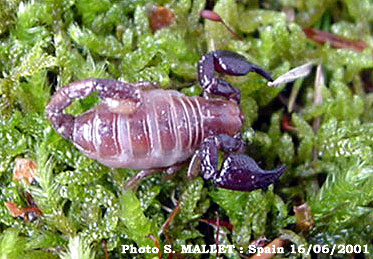Belisarius xambeui
Simon, 1879
|
|

|
|
Common names:
No common name. The taxonomic position of this
species is unclear. It has been placed in several other
families previously, and is now placed in the family
Troglotaoysicidae together with another troglophilic
species, Troglotayosicus vachoni.
Distribution:
Europe (endemic in the southeastern Pyrenees in France
and in Catalonia in Spain).
Habitat:
This is a troglophilic species which lives in quite high
altitudes (650-1500 m). Its is seldom found deep into
caves, but rather occupy cave entrances. It can also be
found under stones etc., and in connection with abandoned
man-made structures like collapsed chimneys, cellars and
castle ruins.
Venom:
No information, but probably no medical
importance.
Selected litterature:
Kovarik, F. (2000). Cave scorpions. British Tarantula
Society Journal, vol. 16 (1), pp. 21-22.
Auber, M. (1959). Observations sur le biotope et la
biologie du scorpion aveugle: Belisarius xambeui
E. Simon. Vie Miliee, 1959, pp. 160-167.
On the Internet:
General:
This is the rarest scorpion i Europe, which few have
seen. This species lacks eyes and pigmentation, which is
typical for many cave-living animals. This species is 3-4
cm long, and has a pale yellow color (almost
translucent).
This species is reported to have a litter size of
5-14.
It is hard to say how rare this species is in nature.
Some sources say it is quite common in some areas, others
say it it quite rare. I think this scorpion is protected
in Spain.
The species is very rare, and is very rarely kept in
captivity (a few peoples in France and myself have kept this species).
Belisarius xambeui
photo by Serge Mallet (C).
|

